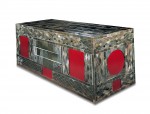 A new exhibition opening next month at the Asian Art Museum in San Francisco Tomb Treasures: New Discoveries from China’s Han Dynasty will display 160 artifacts discovered in recent archaeological digs of Han dynasty tombs. Very few of these objects have never left China, and this is the show’s only US stop. The exhibition opens on February 17th and runs until May 28th, so don’t dally in making your way there.
A new exhibition opening next month at the Asian Art Museum in San Francisco Tomb Treasures: New Discoveries from China’s Han Dynasty will display 160 artifacts discovered in recent archaeological digs of Han dynasty tombs. Very few of these objects have never left China, and this is the show’s only US stop. The exhibition opens on February 17th and runs until May 28th, so don’t dally in making your way there.
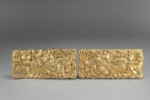 The rule of the Han dynasty (206 BC–220 AD) is considered the first Chinese golden age, a period of relative peace and great economic prosperity in which the arts, sciences and trades flourished. Most of what we know of the Han emperors and their courts comes from ancient chroniclers, but they tend to focus on major events — wars, diplomacy, political intrigue — paying little attention to the
The rule of the Han dynasty (206 BC–220 AD) is considered the first Chinese golden age, a period of relative peace and great economic prosperity in which the arts, sciences and trades flourished. Most of what we know of the Han emperors and their courts comes from ancient chroniclers, but they tend to focus on major events — wars, diplomacy, political intrigue — paying little attention to the  daily lives even of the rich and royal. Because Han nobles built large tomb complexes with multiple rooms filled with every necessity and luxury to ensure their high standard of living would carry over into the afterlife, objects discovered in tombs lend unique insight into the day-to-day of Han dynasty monarchs, their families, functionaries and courtiers.
daily lives even of the rich and royal. Because Han nobles built large tomb complexes with multiple rooms filled with every necessity and luxury to ensure their high standard of living would carry over into the afterlife, objects discovered in tombs lend unique insight into the day-to-day of Han dynasty monarchs, their families, functionaries and courtiers.
 Most of the artifacts in the exhibition were unearthed from the mausoleum of Liu Fei in China’s eastern Jiangsu province. Liu Fei was the son of Emperor Jing of Han (r. 157–141 B.C.). He ruled the valuable fiefdom Jiangdu from 153 B.C. until his death in 127 B.C. He was interred a vast tomb complex of almost 2.7 MILLION square feet that included the tombs of his wives, concubines and
Most of the artifacts in the exhibition were unearthed from the mausoleum of Liu Fei in China’s eastern Jiangsu province. Liu Fei was the son of Emperor Jing of Han (r. 157–141 B.C.). He ruled the valuable fiefdom Jiangdu from 153 B.C. until his death in 127 B.C. He was interred a vast tomb complex of almost 2.7 MILLION square feet that included the tombs of his wives, concubines and  attendants, plus weapons and chariot pits. The tomb was discovered on Dayun Mountain in 2009. Even though it had been looted repeatedly since antiquity, the floors of the outer chambers collapsed early enough in the tomb’s existence to preserve artifacts stored in the chambers below. Archaeologists found more than 10,000 artifacts crammed into storage rooms.
attendants, plus weapons and chariot pits. The tomb was discovered on Dayun Mountain in 2009. Even though it had been looted repeatedly since antiquity, the floors of the outer chambers collapsed early enough in the tomb’s existence to preserve artifacts stored in the chambers below. Archaeologists found more than 10,000 artifacts crammed into storage rooms.
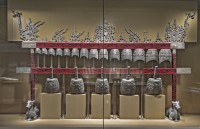 The exhibition is divided into three galleries. The first, Everlasting happiness without end, displays objects that reveal the kinds of entertainment enjoyed in Han dynasty palaces: music, dancing, food, wine. Artifacts include musical instruments, most notably a set of bronze bells and stone chimes that would have been used only on formal court occasions, smoke-eating lamps to keep the party going well into the night and ceramic
The exhibition is divided into three galleries. The first, Everlasting happiness without end, displays objects that reveal the kinds of entertainment enjoyed in Han dynasty palaces: music, dancing, food, wine. Artifacts include musical instruments, most notably a set of bronze bells and stone chimes that would have been used only on formal court occasions, smoke-eating lamps to keep the party going well into the night and ceramic 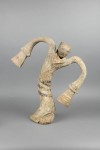 dancers captured in dynamic movement. Containers used to prepare and eat food held offerings that would nourish the Han ruler in the afterlife had ritual significance in tombs, and elegant dinnerware like jade cups, bronze bowls and tables inlaid with gold and gemstones ensured their heavenly food would be eaten in the high style to which they had become accustomed.
dancers captured in dynamic movement. Containers used to prepare and eat food held offerings that would nourish the Han ruler in the afterlife had ritual significance in tombs, and elegant dinnerware like jade cups, bronze bowls and tables inlaid with gold and gemstones ensured their heavenly food would be eaten in the high style to which they had become accustomed.
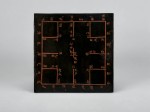 The second, Eternal life without limit, is set in a tomb-like space and features artifacts used to prepare the deceased for the afterlife and to prevent the decay of the flesh. There are medical implements and divination tools, but jade is the star player here. It was used in Chinese burials long before the Han dynasty (or any dynasty at all, for that matter) because it was considered to have the power to prevent the decay of the flesh. The Han took jade funerary artifacts to new heights. They believed that people had two souls, one that went straight to heaven after death, the other that stayed in the body. To keep the
The second, Eternal life without limit, is set in a tomb-like space and features artifacts used to prepare the deceased for the afterlife and to prevent the decay of the flesh. There are medical implements and divination tools, but jade is the star player here. It was used in Chinese burials long before the Han dynasty (or any dynasty at all, for that matter) because it was considered to have the power to prevent the decay of the flesh. The Han took jade funerary artifacts to new heights. They believed that people had two souls, one that went straight to heaven after death, the other that stayed in the body. To keep the 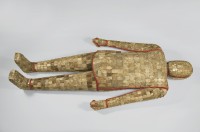 latter safe inside an intact body, the dead were covered in jade. Jade plugs were placed in all orifices and jade masks on the face. If the deceased was of high enough rank — emperor, king, important nobles — the body would be put in a suit made from hundreds of jade scales. An exquisite jade suit from the tomb of Queen Lian, Liu Fei’s second and likely favorite wife, is a highlight of this gallery.
latter safe inside an intact body, the dead were covered in jade. Jade plugs were placed in all orifices and jade masks on the face. If the deceased was of high enough rank — emperor, king, important nobles — the body would be put in a suit made from hundreds of jade scales. An exquisite jade suit from the tomb of Queen Lian, Liu Fei’s second and likely favorite wife, is a highlight of this gallery.
 The theme of the third gallery is Enduring remembrance without fail. It explores the private, personal spaces of Han palaces, exhibiting objects from people’s bedrooms and bathrooms. Artifacts in this gallery include personal hygiene and grooming tools, a silver bath basin, incense burners, lacquer cosmetics boxes and sex toys. There are gifts from kings to their wives and lovers — silver belt hooks, a bronze mirror, a jade pendant — identifiable as such from inscriptions. There’s even an earthenware model of a toilet from the 2nd century B.C. found in 1995
The theme of the third gallery is Enduring remembrance without fail. It explores the private, personal spaces of Han palaces, exhibiting objects from people’s bedrooms and bathrooms. Artifacts in this gallery include personal hygiene and grooming tools, a silver bath basin, incense burners, lacquer cosmetics boxes and sex toys. There are gifts from kings to their wives and lovers — silver belt hooks, a bronze mirror, a jade pendant — identifiable as such from inscriptions. There’s even an earthenware model of a toilet from the 2nd century B.C. found in 1995 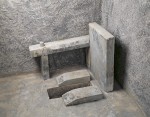 in the tomb of the King of Chu dug into Jiangsu’s Tuolan Mountain.
in the tomb of the King of Chu dug into Jiangsu’s Tuolan Mountain.
I’d like to conclude with a special note of thanks to Zac Rose of the Asian Art Museum for the beautiful photographs and wealth of information he was kind enough to share with me. I’ve written about ancient Chinese tomb discoveries before, and I would have written about more of them had there been any remotely usable pictures. There’s no relief once artifacts are in museums either, since most Chinese museums don’t have detailed pictures of their collection online. Getting such spectacular high resolution shots of recently excavated artifacts from Han tombs is an incredibly rare treat and I’m so grateful.
And now, even more pictures!
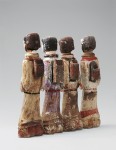
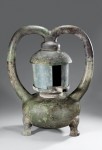
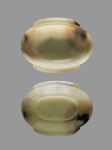
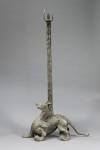
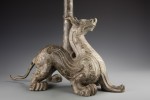
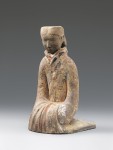


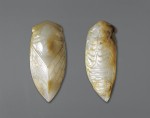

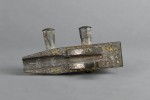
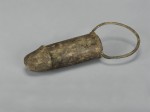
I need a mnemonic for remembering which dynasty came when. Any offers?
At least with Egypt I know the sequence, howsoever vague I might be on the timing. At least I assume I know the sequence; are there any subtleties I should be aware of?
Easy:
三皇五帝夏商周
春秋戰國秦漢流
三國魏晉南北隋
唐宋元明清民收
:hattip:
All that flap yesterday over a tent, yet the upright members hardly penetrated the discussion. 🙂
And those phalli? Were they used as sexual toys, or as religious fetishes?
Was circumcision routinely practiced? The phallus pictures imply that it was so. I will refrain from my usual rant about mutilation of helpless babies. (Aren’t you glad?)
I love the archer figures! How big are they?
I too like the archers. Also love the lamp in the shape of a deer. Thanks for sharing this post.
That one sex toy, fourth photo from the top, looks particularly unpleasant. :confused:
I’m sure they warmed ’em up before use.
😆
Wow, wish I wasn’t on the opposite side of the country 🙁
I think I may have seen a Jade Suite much like that, if not that, in Nanjing in 2001. Well worth seeing in person for it’s stunning beauty.